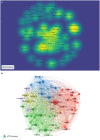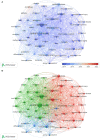A bibliometric analysis of the research hotspots and frontiers related to cell death in spinal cord injury
- PMID: 38249747
- PMCID: PMC10797099
- DOI: 10.3389/fneur.2023.1280908
A bibliometric analysis of the research hotspots and frontiers related to cell death in spinal cord injury
Abstract
Background: Spinal cord injury (SCI) is a severe central nervous trauma that can cause serious consequences. Cell death is emerging as a common pathogenesis after SCI. In the last two decades, numerous studies have been published in the field of cell death after SCI. However, it is still rare to find relevant bibliometric analyses. This bibliometric study aims to visually represent global research trends in the field of cell death after SCI.
Methods: Bibliometric data were sourced from the Web of Science Core Collection (WoSCC) database. VOSviewer, CiteSpace, and R software ("bibliometrix" package) were used to analyze and visualize bibliometric data. Annual scientific production, countries/regions, institutions, authors, journals, highly cited papers, keywords, and literature co-citation were evaluated to determine research performance.
Results: An analysis of 5,078 publications extracted from the WoSCC database revealed a fluctuating yet persistent growth in the field of cell death after SCI over the past 23 years. China and the United States, contributing 69% of the total publications, were the main driving force in this field. The Wenzhou Medical University from China contributed to the most papers. In terms of authors, Salvatore Cuzzocrea from the University of Messina had the highest number of publications. The "Journal of Neurotrauma" was the top journal in terms of the number of publications, however, the "Journal of Neuroscience" was the top journal in terms of the number of citations. The theme of the highly cited articles mainly focused on the mechanism of cell death after SCI. The keyword and literature co-citation analysis mainly focused on the mode of cell death, mechanism research of cell death, and functional recovery after SCI.
Conclusion: This study analyzes the research hotspots, frontiers, and development trends in the field of cell death after SCI, which is important for future studies.
Keywords: apoptosis; bibliometric analysis; cell death; research hotspots; spinal cord injury.
Copyright © 2023 He, Yu, Zhang, Wu, Han and Ma.
Conflict of interest statement
The authors declare that the research was conducted in the absence of any commercial or financial relationships that could be construed as a potential conflict of interest.
Figures









Similar articles
-
Research hotspots and trends of microRNAs in spinal cord injury: a comprehensive bibliometric analysis.Front Neurol. 2024 May 21;15:1406977. doi: 10.3389/fneur.2024.1406977. eCollection 2024. Front Neurol. 2024. PMID: 38836004 Free PMC article.
-
Bibliometric and visual analysis of spinal cord injury-associated macrophages from 2002 to 2023.Front Neurol. 2023 Nov 21;14:1285908. doi: 10.3389/fneur.2023.1285908. eCollection 2023. Front Neurol. 2023. PMID: 38073628 Free PMC article.
-
Research hotspots and frontiers of machine learning in renal medicine: a bibliometric and visual analysis from 2013 to 2024.Int Urol Nephrol. 2025 Mar;57(3):907-928. doi: 10.1007/s11255-024-04259-3. Epub 2024 Oct 30. Int Urol Nephrol. 2025. PMID: 39472403 Review.
-
Global trends and hotspots of neuromodulation in spinal cord injury: a study based on bibliometric analysis.J Orthop Surg Res. 2025 Mar 14;20(1):275. doi: 10.1186/s13018-025-05674-7. J Orthop Surg Res. 2025. PMID: 40082909 Free PMC article.
-
Global Trends in Research of Gouty Arthritis Over Past Decade: A Bibliometric Analysis.Front Immunol. 2022 Jun 10;13:910400. doi: 10.3389/fimmu.2022.910400. eCollection 2022. Front Immunol. 2022. PMID: 35757713 Free PMC article.
Cited by
-
Bibliometric and visualization analysis of hydrogel research in spinal cord injury: comparative study of Chinese and English literature.Front Neurosci. 2025 Jul 10;19:1636904. doi: 10.3389/fnins.2025.1636904. eCollection 2025. Front Neurosci. 2025. PMID: 40708685 Free PMC article.
-
Research trends and hotspots in clinical trials of migraine in the past 20 years: bibliometric analysis.Front Neurol. 2024 Oct 25;15:1430138. doi: 10.3389/fneur.2024.1430138. eCollection 2024. Front Neurol. 2024. PMID: 39524909 Free PMC article.
References
Publication types
LinkOut - more resources
Full Text Sources
Miscellaneous

